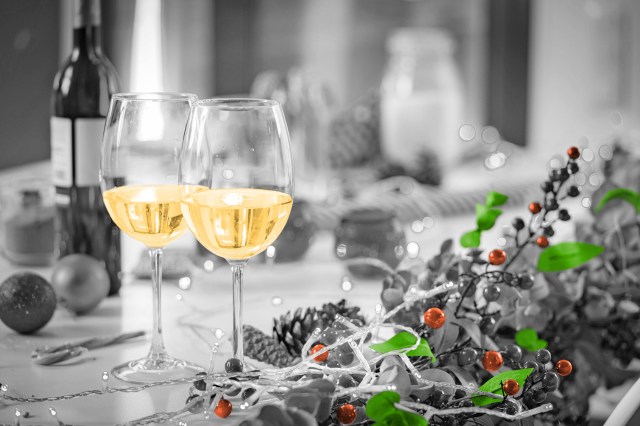
Eggnog
Eggnog may be the most popular Yuletide beverage, with a history dating back to the Middle Ages. Many food historians believe modern eggnog is a descendant of posset, a milky, ale-like drink served warmed in medieval Britain. By the 13th century, posset had become popular among monks and was used in celebrations and toasts as a nod to good health and prosperity, since it contained sherry, milk, and eggs (all foods eaten by the wealthy). Sherry was eventually swapped for rum in the American colonies, though some early versions, like George Washington’s personal recipe, included bourbon whiskey instead.

Wassail
Wishing someone “waes hael” is how the spiced and spiked wassail drink got its name. Traditionally celebrated on Twelfth Night (January 5), the Anglo-Saxon tradition of wassailing was meant either to ensure a good harvest in the new year or to share goodwill and blessings. In the case of the latter, members of the ruling class would serve wassail — a hot spiced drink made from cider, ale, or wine — and wish their guests good health and well-being in the year ahead. Over time, wassailing celebrations went mobile, with groups going house to house with a bowl of the beverage, singing songs, and spreading holiday cheer.

Hot Toddy
National Hot Toddy Day is marked on January 11, though it’s unclear where the warmed drink originated. Some historians believe the beverage was first served in India, where written descriptions from 1786 describe the “taddy” as an alcoholic drink made from liquor, hot water, sugar, and spices. Other lore suggests hot toddies were the invention of a doctor, who blended brandy, sugar, and cinnamon together to help patients battle their colds.
More Interesting Reads

Hot Buttered Rum
Hot buttered rum — a warmed drink made with rum, spices, hot water, and butter — is a cousin to the hot toddy, created in colonial America at a time when alcohol was widely believed to have medicinal benefits. Rum was the preferred drink of the colonists — who, by some estimates, consumed 3.7 gallons per person each year — in part because it was made from molasses, a sweetener that was easier and cheaper to obtain than refined sugar. Colonists believed rum was nutritious and that it could fortify the body, particularly during the coldest months of the year, though historians are unsure how butter became an ingredient in the drink.

Mulled Wine
Many historians believe the ancient Greeks were the inventors of mulled wine, creating the warmed and spiced drink they called ypocras as a way to use leftover wine. The ancient Romans followed suit, calling their version conditum paradoxum, and blending wine with honey and spices as a way to preserve the alcohol for long journeys. By the Middle Ages, mulled wine had become popular throughout Europe, because people believed the spices made the drink healthier. The libation’s association with the winter holidays was cemented in the 1800s, thanks to Charles Dickinson’s inclusion of a type of mulled wine in A Christmas Carol.

Coquito
Coquito, a holiday drink served in Puerto Rican communities, translates to “little coconut,” an apt description since it contains coconut milk and cream, along with spices, sweetened condensed milk, and rum. It’s possible that the drink was introduced to the Caribbean nation by Spanish colonists, though many people believe the chilled, creamy beverage is an invention that first appeared around the early 1900s. By the 1950s, coquito recipes made their way into cookbooks, and today the drink is so synonymous with the Christmas season that it has its own day of celebration — December 21.

Moscow Mule
Compared to other classic holiday drinks, Moscow mules are relatively new; the cocktails containing vodka, lime juice, and ginger beer are less than 100 years old. The recipe has been attributed to multiple people in recent years, but the most widely circulated story claims it originated with John Martin, president of alcohol producer Heublein, which acquired the rights to Smirnoff Vodka in the late 1930s. Martin is said to have co-created the Moscow mule in an attempt to drum up vodka sales, with the help of Jack Morgan, a California bar owner who was trying to market his unpopular ginger beer concoction. The duo released their drink recipe in 1941, not only popularizing the beverage but serving it in copper mugs, which cocktail mythology suggests may have come from a third person looking to popularize their cups.

Champagne
Celebrating New Year’s Eve with a Champagne toast didn’t become a tradition until the late 19th or early 20th century, and it was mostly thanks to restaurant owners. Prior to the 1800s, it wasn’t common to mark the start of a new year by staying up past midnight, and in France, Champagne was typically reserved for state affairs, used to toast diplomatic meetings, coronations, and treaties. Following the French Revolution, however, Champagne became accessible to all classes, and the wealthy who fled the country helped create a market for the bubbly outside of France. By the mid-1800s, Champagne and sparkling wine sales surged in the U.S., and by the early 1900s, many restaurateurs provided it as the only refreshment option for New Year’s Eve meals, linking the drink to the holiday for a century to come.












